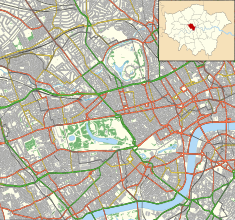| Chiltern Court | |
|---|---|
 "a stately classical pile" | |
| Type | Block of flats |
| Location | Baker Street, London |
| Coordinates | 51°31′22″N 0°09′23″W / 51.5227°N 0.1564°W |
| Built | 1927-29 |
| Architect | Charles Walter Clark |
| Architectural style(s) | Neo-classical |
Chiltern Court, Baker Street, London, is a large block of flats at the street's northern end, facing Regent's Park and Marylebone Road. It was built between 1927 and 1929 above Baker Street tube station by the Metropolitan Railway.
It was begun in 1912 and was originally intended as a hotel and as its company headquarters, but the Metropolitan's plans were interrupted by the First World War. When construction recommenced in the late 1920s, the building was redesigned as a block of flats and the Chiltern Court Restaurant. The architect was Charles Walter Clark.
During the 1930s the block was home to a number of notable figures, including the writers H. G. Wells, who held a weekly literary salon at his apartment, and Arnold Bennett, who died at the Court in 1931. The composer Eric Coates lived in the block between 1930 and 1936, and the cartoonist David Low was also a resident. During World War II, the Special Operations Executive was based at 64 Baker Street, and its Norwegian Section was located in three flats at Chiltern Court, from where it directed the operations against the heavy water plant at Telemark.
Chiltern Court is not listed, being specifically excluded from the listing designation for Baker Street tube station. It is recorded in Pevsner, where it is described as "a stately classical pile, the grandest [of the] mansion flats" in the vicinity.[1] The Chiltern Court Restaurant, now a bar, was referenced by John Betjeman in his television programme from 1973, Metro-land.
- ^ Cherry & Pevsner 2002, p. 658.
